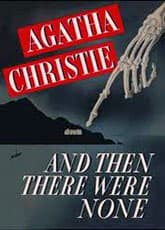And Then There Were None
Critique • Quotes • At the movies
 First US edition, 1940
First US edition, 1940And Then There Were None
Also known as
Ten Little Indians
First publication
1939
Literature form
Novel
Genres
Crime, mystery
Writing language
English
Author's country
England
Length
Approx. 53,500 words

The survivors count the number of figurines left partway through 1945's And Then There Were None.
Killing entertainment
And Then There Were None (1945): Film, 97 minutes; director René Clair; writer Dudley Nichols; featuring Barry Fitzgerald, Walter Huston, Louis Hayward, C. Aubrey Smith, Judith Anderson
To no one's surprise the best-selling murder mystery of all time has spawned numerous adaptations for stage, cinema, television and video games. The fictional versions for large and small screens alone add up to more than two dozen — in a variety of languages from around the world.
What may be surprising is how good most of them are. In fact, a case could be made that the films and TV shows present And Then There Were None to better effect than Agatha Christie's original words do.
Readers of the printed text are sure to spot the many implausibilities in the murder mystery—starting with the unlikeliness of all the strangers, each hiding tragic secrets, gathering at a remote location at the invitation of someone they don't know, and continuing with each of them acting in the exact way at the exact time required to meet death in the prescribed manner. More literary readers may also bemoan the hasty characterizations.
However, a sharp, suspenseful movie can skip past these problems quickly without giving the viewer time to think critically, and clever actors embodying the characters can add depth of their own. In longer, stretched-out adaptations, such as miniseries, screenwriters can add all kinds of detail and back story to turn the implausibilities plausible and involve us in a seemingly realistic tale.
Bloodless classic
The first movie made of And Then There Were None didn't nearly replicate the popularity of the novel published only a few years earlier. But it has worn very well.
In terms of thrills and chills, the 1945 Hollywood flick is tame compared to the typical later horror slasher in which everyone in a remote setting is knocked off one by one with a maximum of gore and grisly detail. The black-and-white film follows Christie's predilection for bloodless killing. There is undoubtedly blood at most of the murder scenes, but we never see more than a drop.
And the suspense in this film, as in other Christie flicks, is never visceral. We never cower in our seats, cringing over what's to come. Rather the events unfold mechanically. The suspense all comes from trying to second-guess the writer. Who's going to be next to die? What's the secret past that makes each seemingly respectable character a target? Who's going to be left?
The international cast is fully aware that they are there to entertain and they play their short-lived roles to the hilt. Irish actor Barry Fitzgerald is (as always) a delight, this time as the main character, the former judge haunted by the execution of an innocent man. (His name, by the way, is changed from the novel's ominous Wargrave to the more ambivalent Quinncannon.) Canadian Walter Huston is likewise compelling as the doctor whose drunkenness led to the death of patient. The two join forces for part of the movie to try to solve the mystery together in a delicious bit of misleading camaraderie.
Dashing British-American actor Louis Haywood and Australia's accomplished actress Judith Anderson are winning as the romantic leads who keep us guessing about whether each is to be trusted.
In the beginning there were ten on the island in 1945's And Then There Were None.
This film version of And Then There Were None seems to have come when the title had been changed from Ten Little Indians (and previously from something even worse), though the nursery rhyme and figurines on the "Ten Little Indians" theme are still featured. (Some later adaptations would change the doggerel to "Ten Little Soldier Boys".)
Of more dramatic import, the conclusion has been changed from the novel in line with the 1943 stage production, written by Christie herself, leaving two of the ten characters innocent and alive at the end.
The slow reveal of the host 's identity near the end and the explanation of the plot is satisfying. The death of the villain by self-administered poison just seconds after it becomes evident their plot has failed, though, is anticlimactic.
This may not be the very best or most popular adaptation of the famous crime novel, but it's the classic one that all later attempts are measured against.
By the way, a colorized version of this film is also available, though its bright and golden hues seem to wash from the mystery whatever dread remains.
— Eric

